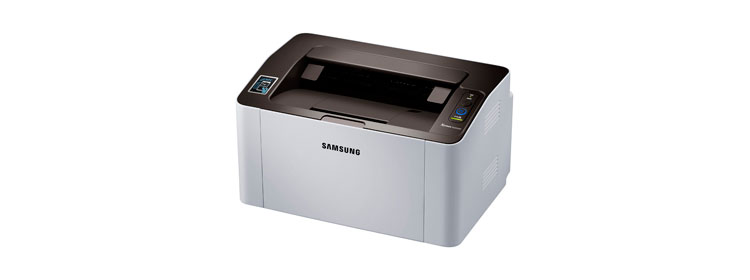Clearly designed for personal, rather than office use, the Samsung Xpress M2020W ($129.99) monochrome laser printer offers reasonably good speed along with output quality that’s good enough for most business needs. It also offers Wi-Fi, Wi-Fi Direct, and NFC support, which gives it an edge over much of its competition. Unfortunately, its running cost is high enough to be a potential issue if you need it for anything more than extremely light-duty use.
Like the Brother HL-2240$81.93 at Amazon and Samsung’s own Xpress M2625D$71.09 at Amazon, which is our Editors’ Choice for a low-cost personal monochrome laser, the M2020W$68.79 at Amazon is smaller than most inkjets, at 7.0 by 13.0 by 8.5 inches. The combination of the small size and a low paper capacity, at 150 sheets, is what defines the M2020 as a personal printer.
One advantage the M2020W has over both the Brother HL-2240 and Samsung M2625D is its Wi-Fi support, although not in the way you might think. Although Wi-Fi will let you share the printer easily on a network in a micro office, the low paper capacity could leave you refilling the tray a lot.
The more attractive use of Wi-Fi is for mobile printing. Connect the printer to a network, and you can print from a phone or tablet though a Wi-Fi access point. Even better, the Wi-Fi support includes Wi-Fi Direct, which means you can connect directly from a mobile device to print, even if the printer isn’t on a network. And if your phone or tablet supports NFC, you can also connect simply by touching it to a clearly marked spot on the printer. In my tests, I connected this way with a Samsung Galaxy S III and printed without problems.
Setup, Speed, and Output Quality
Setup is standard for a monochrome laser. For my tests, I connected by USB cable and printed from a Windows Vista system.
Samsung rates the M2020W at 21 pages per minute (ppm), which is the speed you should see when printing text files or other output with little to no formatting. On our business applications suite (using QualityLogic’s hardware and software for timing) it came in at 9.2ppm, which is appropriately fast for the rating. However, it’s a touch slower than the Samsung M2625D, at 9.9ppm, and significantly slower than the Brother HL-2240, at 11.4ppm.
The output quality is best described as good enough for most purposes, but not impressive. Text quality was at the low end of the range where the vast majority of monochrome lasers fall, which means it’s not quite good enough for high-quality desktop publishing, but more than good enough for almost any business use.
Graphics output was absolutely par for a monochrome laser. That makes it easily good enough for any internal business use. Most people would also consider it good enough for PowerPoint handouts and the like. Photos were at the low end of a very tight range where virtually all monochrome lasers fall, making them good enough for applications like printing recognizable photos from webpages, but not much more than that.
The one potentially serious drawback for the M2020W is its running cost, at 5.3 cents per page. In comparison, the Samsung M2625D claims 3.9 cents per page, and the Brother HL-2240 claims 3.8 cents. Compared with either of those two models, that works out to a difference of at least $1.40 for every 100 pages, $14 for every 1,000 pages, and $140 for every 10,000 pages. If you don’t expect to print many pages over the printer’s lifetime, the running cost may not be an issue. However, the more you print, the higher the difference in total cost of ownership will be.
If you have no need for the wirerless printing options in the Samsung Xpress M2020W, you will almost certainly be better off with either the Brother HL-2240 or the Editors’ Choice Samsung M2625D. Both deliver higher paper capacities and lower running costs, with the Brother HL-2240 delivering significantly faster speed and the Samsung M2625D adding a duplexer.







